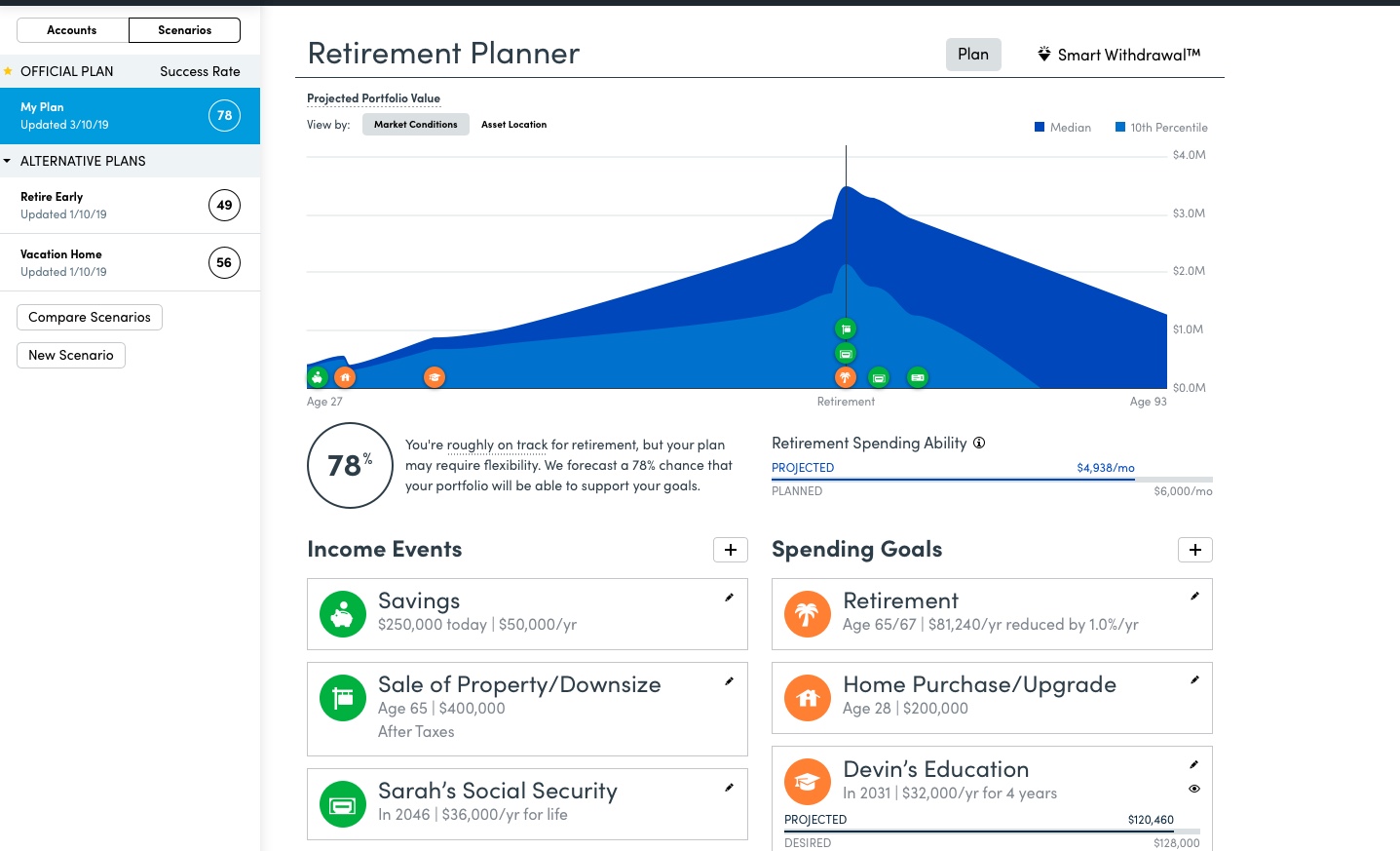
Even though it may seem like an insignificant amount, average fees paid to financial advisors can reach thousands of dollar per year. That is the equivalent of one percent of your annual income. This fee covers the fees of the advisor's employer, the middleman firm and a few other expenses. The middleman firm (or the employer) may take 60 to 80% of your fee. Your money could also be used for advertising, luxurious office space, or company parties.
Rates of return on client assets
It doesn't matter whether your clients have mutual funds, stock accounts or other assets. You need to be aware of the rate that these assets earn. Investment firms must find a way to return client assets as effectively and efficiently as possible. These figures may vary from month to month. In order to calculate your return on client assets, you must first know how much your client assets are worth.
The ROA can be used to compare your business to other businesses. An auto manufacturer might have a 4% ROA while a software company may have an 18% ROA. Although the former may seem less than those of its competitors, it is actually significantly higher than that of the average industry. It's important that you understand that the return of client assets will vary depending on which assets are required for a business to be competitive.

Costs of investing on your own
The costs of investing on your own without a financial adviser vary depending on how complex your financial situation is. A low-cost financial advisor can be a good option for individuals with modest net worth who have a simple investment strategy. A robo-advisor is another low-cost option to financial advisors.
A financial advisor's fees are typically based on how much you invest. These fees can vary from 1% to 3.3% of your total assets. The hourly fee for fee-only advisors could be $100-300. Be aware of the potential for poor financial decisions.
Financial advisors may charge fees
An asset under management fee (AUM), which is often charged to a financial advisor to manage your investments, or an hourly charge, will be paid. This fee is the percentage that your financial advisor manages on behalf of you. The fee can be much lower with robo advisors and online advisors, while traditional financial advisors typically charge 0.25% to 0.30% of your AUM. Additional products and services may be available. An hourly fee is usually reserved for special planning or consulting and can range from $130 to $300 an hour.
Average financial advisor fees vary based on the complexity of your investments. You can negotiate with your financial advisor to lower your fees. If the fees seem excessive, explain why. If you have less than $100,000 to invest, you might be able to justify paying less for the same level of service.

Comparison of commission-based and fee-based models: What impact?
Despite differences in compensation, there's been a shift towards fee-based models for financial advice in recent times. These models allow fee-based advisors greater flexibility when it comes to the type of investments they offer, such as insurance products. Fee-based advisors have had more opportunities to incorporate insurance products, which can provide clients with a higher return than commission-based products.
Many wealth managers in the US have started to move more assets of their clients to fee-based accounts. This lowers risk and ensures a steady revenue stream. This shift has pushed them to experiment with their advisor compensation plans.
FAQ
What is risk-management in investment management?
Risk management is the act of assessing and mitigating potential losses. It involves identifying and monitoring, monitoring, controlling, and reporting on risks.
Investment strategies must include risk management. The goal of risk management is to minimize the chance of loss and maximize investment return.
These are the main elements of risk-management
-
Identifying sources of risk
-
Monitoring and measuring the risk
-
Controlling the risk
-
Manage the risk
How old can I start wealth management
Wealth Management is best done when you are young enough for the rewards of your labor and not too young to be in touch with reality.
The earlier you start investing, the more you will make in your lifetime.
If you're planning on having children, you might also consider starting your journey early.
You may end up living off your savings for the rest or your entire life if you wait too late.
What are the benefits to wealth management?
Wealth management's main benefit is the ability to have financial services available at any time. To save for your future, you don't have to wait until retirement. If you are looking to save money for a rainy-day, it is also logical.
You can invest your savings in different ways to get more out of it.
To earn interest, you can invest your money in shares or bonds. You could also buy property to increase income.
A wealth manager will take care of your money if you choose to use them. You don't have the worry of making sure your investments stay safe.
Statistics
- These rates generally reside somewhere around 1% of AUM annually, though rates usually drop as you invest more with the firm. (yahoo.com)
- A recent survey of financial advisors finds the median advisory fee (up to $1 million AUM) is just around 1%.1 (investopedia.com)
- Newer, fully-automated Roboadvisor platforms intended as wealth management tools for ordinary individuals often charge far less than 1% per year of AUM and come with low minimum account balances to get started. (investopedia.com)
- As previously mentioned, according to a 2017 study, stocks were found to be a highly successful investment, with the rate of return averaging around seven percent. (fortunebuilders.com)
External Links
How To
How to invest your savings to make money
You can generate capital returns by investing your savings in different investments, such as stocks, mutual funds and bonds, real estate, commodities and gold, or other assets. This is called investment. This is called investing. It does not guarantee profits, but it increases your chances of making them. There are many ways to invest your savings. You can invest your savings in stocks, mutual funds, gold, commodities, real estate, bonds, stock, ETFs, or other exchange traded funds. These methods will be discussed below.
Stock Market
The stock market is an excellent way to invest your savings. You can purchase shares of companies whose products or services you wouldn't otherwise buy. Additionally, stocks offer diversification and protection against financial loss. In the event that oil prices fall dramatically, you may be able to sell shares in your energy company and purchase shares in a company making something else.
Mutual Fund
A mutual fund is a pool of money invested by many individuals or institutions in securities. They are professionally managed pools of equity, debt, or hybrid securities. The mutual fund's investment objective is usually decided by its board.
Gold
Gold is a valuable asset that can hold its value over time. It is also considered a safe haven for economic uncertainty. It is also used as a form of currency in some countries. The increased demand for gold from investors who want to protect themselves from inflation has caused the prices of gold to rise significantly over recent years. The price of gold tends to rise and fall based on supply and demand fundamentals.
Real Estate
Real estate can be defined as land or buildings. When you buy realty, you become the owner of all rights associated with it. You may rent out part of your house for additional income. You can use your home as collateral for loan applications. The home may be used as collateral to get loans. You must take into account the following factors when buying any type of real property: condition, age and size.
Commodity
Commodities can be described as raw materials such as metals, grains and agricultural products. These items are more valuable than ever so commodity-related investments are a good idea. Investors who want to capitalize on this trend need to learn how to analyze charts and graphs, identify trends, and determine the best entry point for their portfolios.
Bonds
BONDS ARE LOANS between companies and governments. A bond is a loan agreement where the principal will be repaid by one party in return for interest payments. As interest rates fall, bond prices increase and vice versa. Investors buy bonds to earn interest and then wait for the borrower repay the principal.
Stocks
STOCKS INVOLVE SHARES of ownership within a corporation. Shares only represent a fraction of the ownership in a business. If you own 100 shares, you become a shareholder. You can vote on all matters affecting the business. When the company is profitable, you will also be entitled to dividends. Dividends can be described as cash distributions that are paid to shareholders.
ETFs
An Exchange Traded Fund is a security that tracks an indice of stocks, bonds or currencies. Unlike traditional mutual funds, ETFs trade like stocks on public exchanges. The iShares Core S&P 500 eTF, NYSEARCA SPY, is designed to follow the performance Standard & Poor's 500 Index. If you purchased shares of SPY, then your portfolio would reflect the S&P 500's performance.
Venture Capital
Venture capital is the private capital venture capitalists provide for entrepreneurs to start new businesses. Venture capitalists provide financing to startups with little or no revenue and a high risk of failure. Usually, they invest in early-stage companies, such as those just starting out.